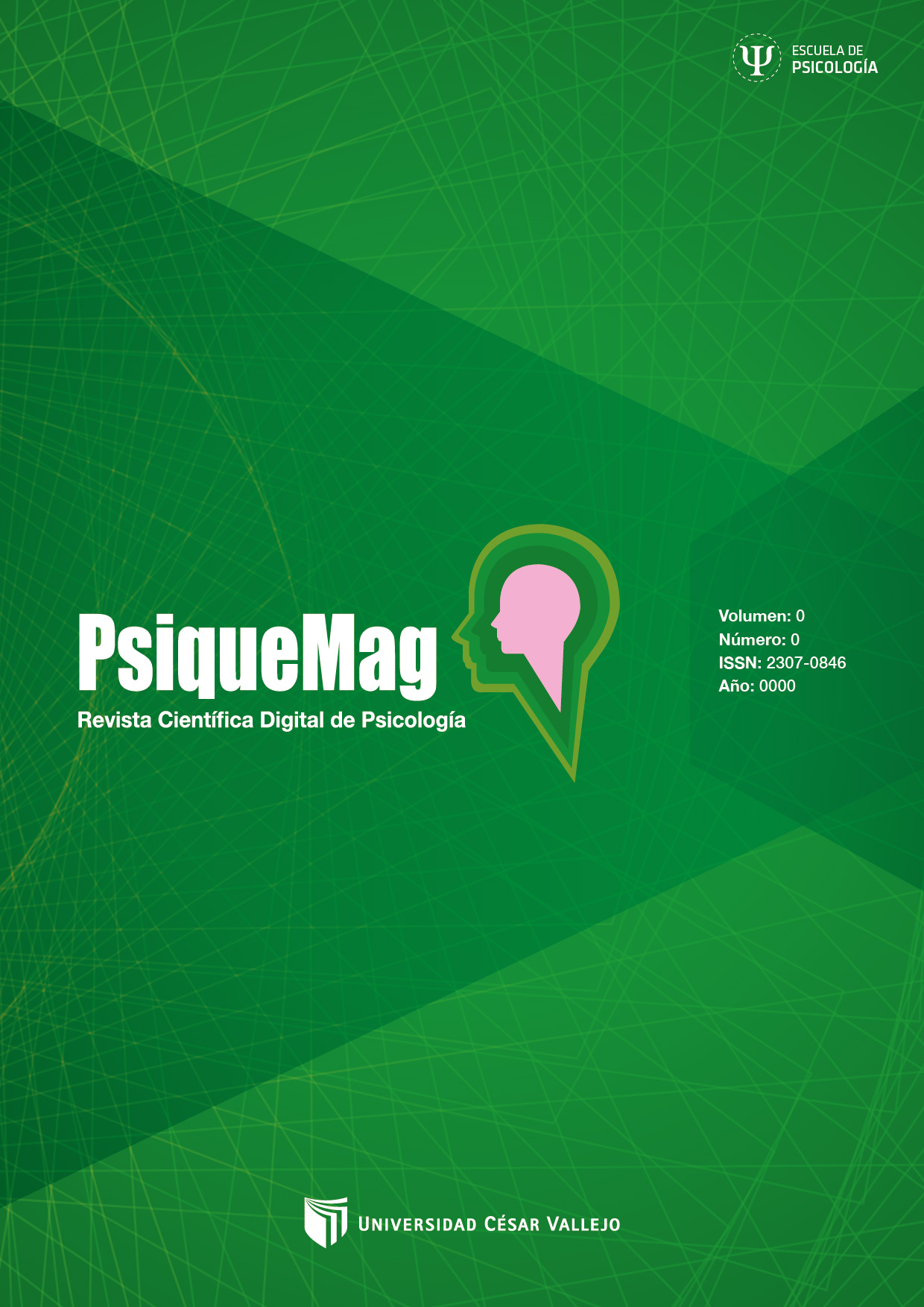Psychometric properties of the state-trait anger expression inventory - STAXI-2 in students of a public university of Lambayeque
DOI:
https://doi.org/10.18050/psiquemag.v13i1.2807Keywords:
State-Trait Anger Expression Inventory-STAXI-2, validity, reliability, college students, psychometric propertiesAbstract
This study analyzes the psychometric properties of the 49-item State-Trait Anger Expression Inventory - STAXI-2 in its Spanish version authored by Miguel-Tobal, Casado, Cano-Vindel and Spielberger. It was administered to students from a public university in Lambayeque which study’s population was made up of 2,205 male and female university students, enrolled in the 2018-II academic semester. Content validity was carried out with 10 expert judges and the reliability was carried out with a pilot sample of 30 students. The factor analysis (FA) was analyzed with a sample of 285 students selected through non random sampling; with a significance level of 0.05 and a confidence level of 95% (0.95). The validity and reliability of the instrument was reported, according to Aiken's V and Cronbach's Alpha Coefficient, finding good internal consistency. Likewise, the CFA using the least squares estimation method turned out to be good, resulting in three factor model: state anger, trait anger, and anger expression and control. It was concluded that the STAXI-2 is a valid and reliable instrument to assess state anger, trait anger, and anger expression and control in students of a public university in Lambayeque.
References
American Psychological Association, APA Task Force on Psychological Assessment and Evaluation Guidelines. (2020). APA Guidelines for Psychological Assessment and Evaluation. https://www.apa.org/about/policy/guidelines-psychological-assessment-evaluation.p
Anastacio, A. L. (2020). Evidencia del análisis psicométrico del inventario de expresión de Ira- Estado –Rasgo (STAXI – 2) en estudiantes universitarios de Piura. [Tesis de Pregrado].https://alicia.concytec.gob.pe/vufind/Record/UCVV_d678617740e2ebe83f6a03e934320b75
Bolarinwa, O. A. (Oct–Dec 2015). Principles and Methods of Validity and Reliability Testing of Questionnaires Used in Social and Health Science Researches. Nigerian Postgraduate Medical Journal, 22(4),195-201. https://pubmed.ncbi.nlm.nih.gov/26776330/
Brett, J.M. y Drasgow, F. (Eds.). (2002). The Psychology of Work: Theoretically Based Empirical Research (1st ed.). Psychology Press. https://doi.org/10.4324/9781410602411
Carretero-Dios, H. y Pérez, C. (2007). Standards for the development and review of instrumental studies: Considerations about test selection in psychological research. International Journal of Clinical and Health Psychology. 7(3), 863-882. https://www.aepc.es/ijchp/carretero_es.pdf
Chereji, S.V., Pintea, S. y David, D. (2012). The relationship of anger and cognitive distortions with violence in violent offenders’ population: a meta-analytic review. The European Journal of Psychology Applied to Legal Context, 4(1): 59-77. https://www.researchgate.net/publication/277272928_The_relationship_of_anger_and_cognitive_distortions_with_violence_in_violent_offenders%27_population_A_meta-analytic_review
Company, R., Oberst, U. y Sánchez, F. (2012). Regulación emocional interpersonal de las emociones de ira y tristeza. Boletín de psicología, 104, 7-36 https://dialnet.unirioja.es/metricas/documentos/ARTREV/3968614
Dash, G. y Paul, J. (2021). CB-SEM vs PLS-SEM methods for research in social sciences and technology forecasting. Technological Forecasting and Social Change, 173. https://doi.org/10.1016/j.techfore.2021.121092
Deffenbacher, J. L., Oetting, E. R., Thwaites, G. A., Lynch, R. S., Baker, D. A., Stark, R. S., Thacker, S., & Eiswerth-Cox, L. (1996). State-Trait Anger Theory and the utility of the Trait Anger Scale. Journal of Counseling Psychology, 43(2), 131–148. https://psycnet.apa.org/doi/10.1037/0022-0167.43.2.131
Delgado, A. E., Escurra, L. M. y Torres, W. (2006). La medición en psicología y educación: teoría y aprendizaje. Editorial HOZLO.
Escurra, L. M. (1988). Cuantificación de la validez de contenido por criterio de jueces. Revista de Psicología, 6(1-2),103-111. https://dialnet.unirioja.es/servlet/articulo?codigo=6123333
Flores, J. C. y Terán, M. M. (2022). Validez de contenido de juicio por expertos en instrumento para medir la influencia de factores psicosociales en el estrés organizacional en empresas del giro hotelero. Revista Compendium: Cuadernos de Economía y Administración, 9(3), 219-231. https://doi.org/10.46677/compendium.v9i3.1130
Gadermann, A. M., Guhn, M. y Zumbo, B. D. (2019). Estimating ordinal reliability for Likert type and ordinal item response data: A conceptual, empirical, and practical guide. Practical Assessment, Research and Evaluation, 17(3). https://doi.org/10.7275/n560-j767
García-Batista, Z. E. et al. (2018). Evidencias de validez y fiabilidad de las Puntuaciones del STAXI-2 para población general y hospitalaria: Estudio con una muestra de adultos de República Dominicana. Suma Psicológica, 25(1), 21-29. https://doi.org/10.14349/sumapsi.2018.v25.n1.3
García-Padilla, A. K., Lara-Vargas, E. J. y Albarracín-Rodríguez, A. P. (2016). Análisis psicométrico del Staxi-2 y el MI-Staxi en adultos del Área Metropolitana de Bucaramanga. Cuadernos Hispanoamericanos de Psicología, 16(2), 5-44. http://scielo.org.co/scielo.php?script=sci_arttext&pid=S0121-43812018000100021
Hernández-Sampieri, R. y Mendoza, C. (2018). Metodología de la investigación. Las rutas cuantitativa, cualitativa y mixta. Editorial Mc Graw Hill Education. https://doi.org/10.22201/fesc.20072236e.2019.10.18.6
Hooper, D., Coughlan, J. y Mullen, M. R. (2008). Structural Equation Modelling: Guidelines for Determining Model Fit. The Electronic Journal of Business Research Methods, 6(1), 53 – 60. https://core.ac.uk/download/pdf/297019805.pdf
Hu, L. T. y Bentler, P. M. (1999). Cutoff criteria for fit indexes in covariance structure analuss: Conventional criteria versus new alternatives. Stuctural Equation Modeling, 6, 1-55. https://doi.org/10.1080/10705519909540||8
Hunsley, J.y Allan, T. (2019). Psychometrics and Psychological Assessment. In M. Sellbom & J. Suhr (Eds.), The Cambridge Handbook of Clinical Assessment and Diagnosis (Cambridge Handbooks in Psychology, pp. 9-24). Cambridge University Press. https://doi.org/10.1017/9781108235433.002
Kaplan, R. M. y Sacuzzo, D. P. (2006). Pruebas psicológicas: Principios, aplicaciones y temas. (6ta ed.). Thomson.
Kocakaya, S. y Kocakaya, F. (2014). A Structural Equation Modeling on Factors of How Experienced Teachers Affect the Students’ Science and Mathematics Achievements. Education Research International, 1-8. https://doi.org/10.1155/2014/490371.b
Kyriazos, T. A. y Stalikas, A. (2018). Applied Psychometrics: The Steps of Scale Development and Standardization Process. Psychology, 9, 2531-2560. https://doi.org/10.4236/psych.2018.911145
Li, Ch. (2016). Confirmatory factor analysis with ordinal data: Comparing robust maximum likelihood and diagonally weighted least squares. Behav Res., 48, 936–949 https://doi.org/10.3758/s13428-015-0619-7
Lickley, R. A. y Sebastian, C. L. (2018) The neural basis of reactive aggression and its development in adolescence. Psychology, Crime and Law, 24(3), 313-333, https://doi.org/10.1080/1068316X.2017.1420187
Lloret, S., Ferreres, A., Hernández, A. y Tomás, I. (mayo, 2017). The exploratory factor analysis of items: guided analysis based on empirical data and software. Anales de Psicología, 33(2), 417-432 https://www.redalyc.org/pdf/167/16750533026_1.pdf
Lown, B. A. (2007). Difficult conversations: anger in the clinician-patient/family relationship. Southern medical journal, 100(1), 33–62. https://doi.org/10.1097/01.smj.0000223950.96273.61
Martínez, M. y Sánchez, R. (enero-junio, 2014). Valoración de Situaciones-Estímulo Que Generan Enojo en Diferentes Relaciones Interpersonales. Revista Colombiana de Psicología, 23(1), 163-175. https://www.redalyc.org/pdf/804/80431219010.pdf
Mayer, E. (2018). Pensar con el estómago: como la relación entre digestión y cerebro afecta a la salud y el estado de ánimo. (3ra ed.). Editorial Grijalbo.
Miguel-Tobal, J. J., Casado, M. I, Cano-Vindel, A. y Spielberger, C. D. (2009). Manual del Inventario de Expresión de Ira Estado-Rasgo. TEA Ediciones.
Mohamad, M. M., Sulaiman, N. L., Sern, L. C. y Salleh, K. M. (2015). Measuring the Validity and Reliability of Research Instruments. Procedia - Social and Behavioral Sciences, 204, 164–171. https://doi.org/10.1016/j.sbspro.2015.08.129
Monteza, K. E. y Pacheco, S. E. (2020). Evidencias de Validez y Confiabilidad del Inventario Expresión de Ira Estado/Rasgo STAXI 2 en Policías de la Ciudad de Trujillo. [Tesis de Pregrado]. https://repositorio.ucv.edu.pe/handle/20.500.12692/46340
Mostofsky, E., Penne, E. A. y Mittleman, M. A. (2014). Outbursts of anger as a trigger of acute cardiovascular events: a systematic review and meta-analysis. European heart journal, 35(21), 1404–1410. https://doi.org/10.1093/eurheartj/ehu033
Neuman, W. L. (2007). Basics of social research: Qualitative and Quantitative Approaches. (2nd ed). Pearson Education, Inc.
O’Hair, C., Grocott, L., McNulty, J. y Temple, J. y Shorey, R. (2022). The Interactive Effect of Alcohol Use and Depressive Symptoms in Predicting Couples’ Risk for Intimate Partner Violence Perpetration. Journal of Family Violence, 38, 1-7. 10.1007/s10896-022-00421-6
Quan, F., Yang, R. y Xia, L.X. (2020). The longitudinal relationships among agreeableness, anger rumination, and aggression. Current Psychology, 40(1), 9-20. https://doi.org/10.1007/s12144-020-01030-6
Santandreu, M. y Ferrer, V. A. (2014). Análisis de la emotividad negativa en mujeres víctimas de violencia de pareja: La culpa y la ira. Revista de Psicopatología y Psicología Clínica, 19(2), 129-140. https://doi.org/10.5944/rppc.vol.19.num.2.2014.13063
Schamborg, S., Tully, R. J, Browne, K.D. (2016). The Use of the State-Trait Anger Expression Inventory-II With Forensic Populations: A Psychometric Critique. Int J Offender Ther Comp Criminol. 60(11), 1239-56. https://doi.org/10.1177/0306624X15577932.
Schuberth, F., Henseler, J. y Dijkstra, T.K. (2018). Partial least squares path modeling using ordinal categorical indicators. Qual Quant, 52, 9–35. https://doi.org/10.1007/s11135-016-0401-7
Tabachnick, B. G. y Fidell, L.S. (2007). Using multivariate statistics (5th ed.). Pearson/Allyn & Bacon.
Titova, O. E., Baron, J. A., Michaelsson, K., y Larsson, S. C. (July, 2022). Anger frequency and risk of cardiovascular morbidity and mortality, European Heart Journal Open, 2(4). https://doi.org/10.1093/ehjopen/oeac050
Yuni, J. y Urbano, C. (2014). Técnicas para investigar. Vol. 2 Recursos metodológicos para la preparación de proyectos de investigación. Editorial Brujas.
Downloads
Published
How to Cite
Issue
Section
License
Copyright (c) 2024 Claudia Dora Vallejos Valdivia

This work is licensed under a Creative Commons Attribution 4.0 International License.
You are free to:
- Share — copy and redistribute the material in any medium or format
- The licensor cannot revoke these freedoms as long as you follow the license terms.
Under the following terms:
-
Attribution — You must give appropriate credit, provide a link to the license, and indicate if changes were made. You may do so in any reasonable manner, but not in any way that suggests the licensor endorses you or your use.












